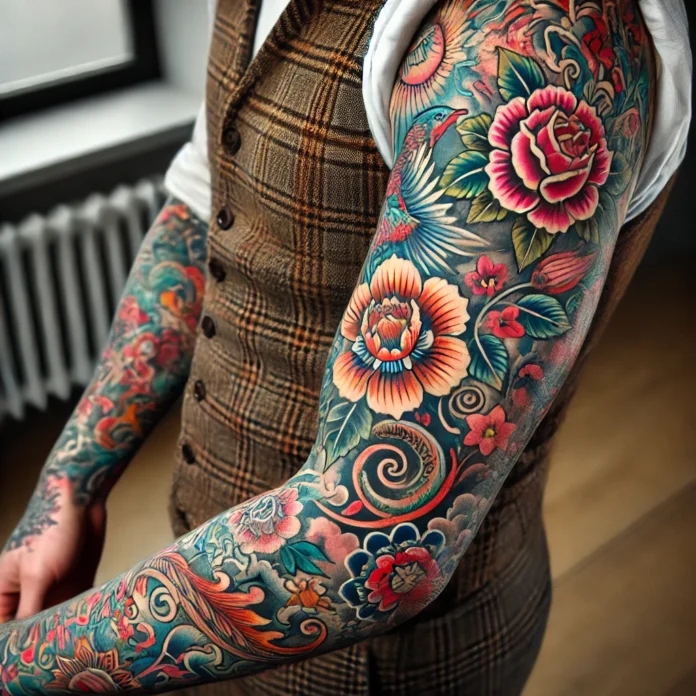Many clients dream of a full sleeve but struggle with choosing the right style, color, and how to start. A poorly planned tattoo sleeve can leave awkward spaces or disconnected parts, making the design feel incomplete. Without proper advice from a skilled artist, the process can be overwhelming.
A custom sleeve should flow seamlessly, enhancing the body while reflecting personal meaning. By collaborating with experts and following a comprehensive guide, you can ensure every detail—from the starting point to filling in the gaps—is carefully thought out. This article will help you make confident decisions, avoid common mistakes, and create a stunning, well-balanced tattoo.
Where to Start with a Custom Sleeve
Many clients don’t realize that their first arm tattoo might lead to a full custom sleeve. The starting point has evolved over time—while people traditionally began at the top and worked their way down, the trends have shifted. Now, many prefer starting with their forearms, likely due to the increasing acceptance of visible tattoos in the workplace. However, the best placement depends on the design and long-term vision.
In some cases, neither the upper arm nor the forearm is the best choice to begin. Discussing plans early on is important, especially for elements like the elbow that require a circular or symmetrical approach. For a patchwork sleeve, where separate tattoos form a whole without a unifying background, larger and more significant images should dictate the initial locations to create a balanced look.
Many questions arise when planning a sleeve, and as an artist, it can feel like a bane to hear vague ideas like, “I just want a full sleeve.” This is where knowledge and a strategically planned approach help. A tattoo sleeve is a major commitment in terms of time and money, and without a clear plan, it can feel overwhelming to comprehend. Being honest about the process ensures clients understand what they’re getting into and make the best decisions for their ink.
Deciding on a Half or Full Sleeve
There are a few obvious points to consider when planning a sleeve. A half sleeve typically runs from the shoulder to the elbow or from the elbow to the wrist, making it a more flexible option. It’s also significantly cheaper than committing to a full sleeve, which is something many clients overlook.
Beyond cost, you need to consider your budget, not just in terms of money but also time and how your lifestyle will allow for it. Some employers and even family members may still judge visible tattoos, which can affect professional and personal situations. While that mindset may seem stupid, it’s a reality worth thinking about before making a final decision.
Cohesive and Eclectic Sleeves
A cohesive sleeve follows a single concept, where the entire piece flows together as one big tattoo. While it looks seamless, it requires careful planning and design to ensure everything connects properly. This isn’t something that happens in a single day, and compared to the eclectic option, it demands a different approach.
Eclectic sleeves are made up of separate tattoos with different elements that simply fit where they work best. Each piece should be carefully selected for different parts of the arm, but unlike a cohesive sleeve, it often leaves negative space. This space can be filled with a background design, blacked out, or left blank, depending on personal taste. The result is a nifty and bold aesthetic, often making it appear as though you have more tattoos than someone with a fully connected sleeve.
Style and Color
A custom tattoo sleeve can showcase a diverse range of styles, including traditional, neo-traditional, realism, and watercolor. When done by the right artist, combining these different styles and colors can create a cohesive look that ties everything together seamlessly.
Collector-style patchwork sleeves are a unique way to blend various styles and colors based on individual pieces. As long as the design feels purposeful and balanced, mixing colorful tattoos with black and gray elements can be very effective, giving the sleeve a dynamic, artistic appeal.
Theme for a Tattoo Sleeve
A custom tattoo sleeve doesn’t have to follow a specific theme. While having a cohesive theme can be enjoyable, it’s not always essential. Clients can choose tattoos with entirely unrelated concepts, yet they can still harmonize beautifully by using a consistent color palette, tone, line weight, or even an illustration style. This flexibility allows for a more personal and creative approach to designing the perfect sleeve.
How Long a Custom Tattoo Sleeve Takes
Creating a custom tattoo sleeve requires careful time and effort. It’s generally best to approach sleeves one or two pieces at a time. The completion of a sleeve can span anywhere from several days to even years, depending on factors such as the frequency of sessions, the artist’s availability, the client’s stamina and pain tolerance, as well as the complexity of the design and the artist’s tattooing speed. Patience and commitment are key when planning for such a significant piece of art.
Conclusion
Creating a custom tattoo sleeve is a unique and personal journey that requires careful planning, time, and commitment. Whether you choose a cohesive theme or mix various styles, it’s important to approach the process with patience. By understanding the time, costs, and effort involved, clients can make informed decisions and work closely with the artist to create a sleeve that truly represents their vision and style.
FAQs
1. How long does a tattoo sleeve take?
It can take anywhere from days to years, depending on the design, sessions, and the artist’s speed.
2. Can I mix tattoo styles in a sleeve?
Yes, different styles can be mixed as long as there’s a consistent color palette and line weight.
3. Do I need a specific theme for a tattoo sleeve?
No, you can have unrelated concepts as long as the design is cohesive through color or style.
